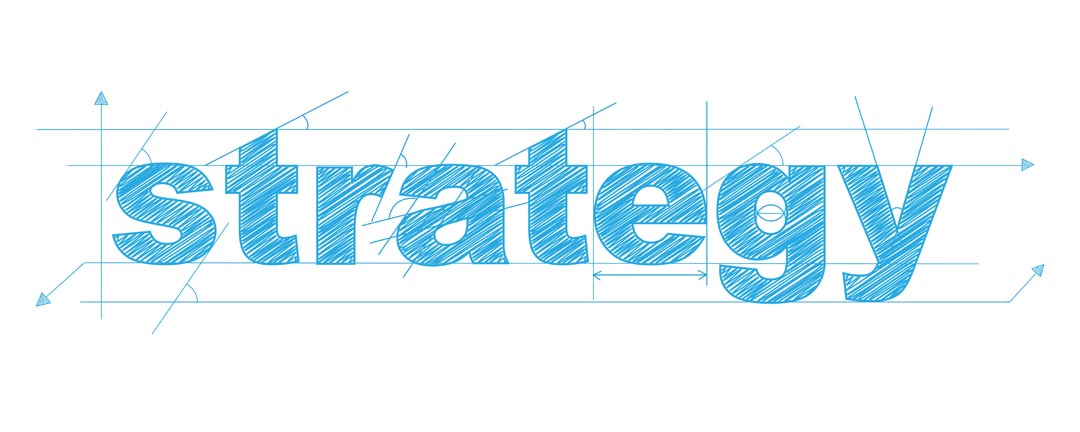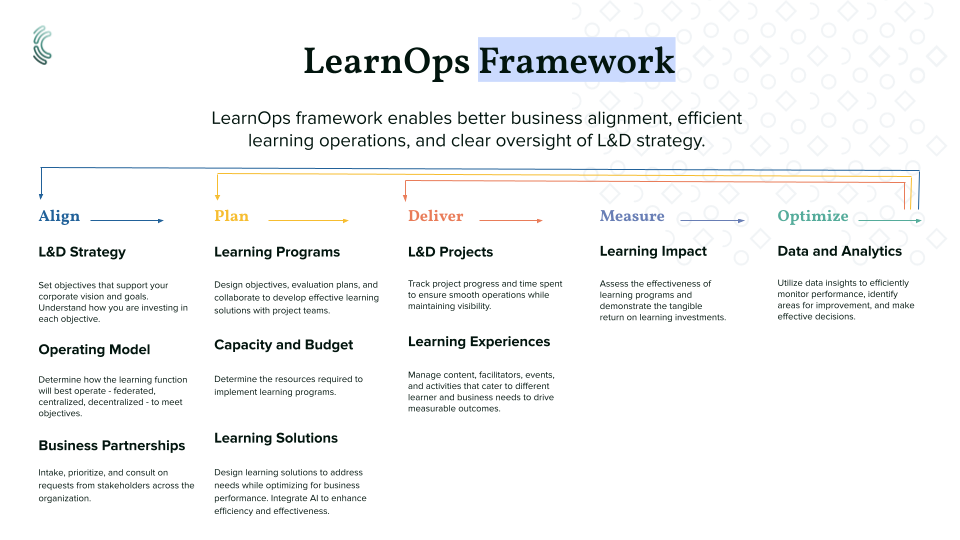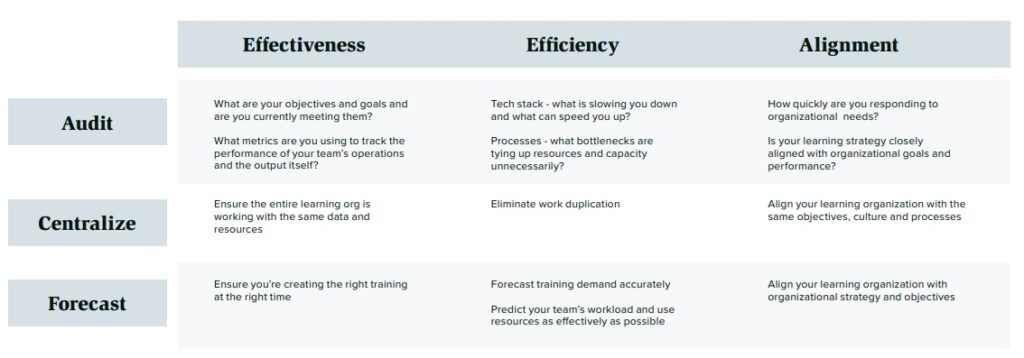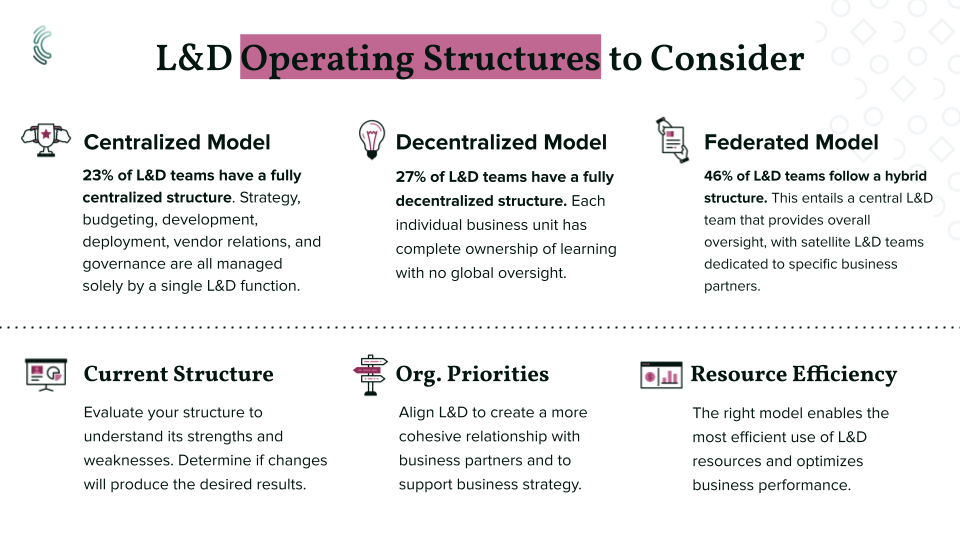Ryan Austin does a deep dive into the transformative potential of LearnOps as an approach to aligning L&D with organisational strategy in this epic feature
In today’s evolving business landscape, aligning learning and development (L&D) with organisational strategy is essential. To achieve this alignment, L&D professionals must embark on a strategic journey articulated through several critical steps, encompassing the adoption of a Learning Operations (LearnOps) approach: a framework that optimises learning operations to drive business outcomes.
A proactive stance is imperative for L&D to transition from a peripheral role to that of a strategic confidant
This journey begins with understanding the company’s strategic goals and extends to fostering a robust learning culture, leveraging data and technology (such as the LMS and LXP you might already have), and sustaining continuous evolution. Each step is pivotal in ensuring that L&D initiatives are not only effective and efficient but also dynamically attuned to the shifting needs and priorities of the business.
This article delves into the ‘align’ phase, the foundational step in the transformative five-stage journey of LearnOps. It will provide an in-depth look at strategies and best practices that can help establish a strong alignment within an organisation, ensuring learning objectives are perfectly synchronised with business goals.
Through LearnOps, L&D can transition from being a reactive service to a proactive force that shapes the organisation’s future.
Step 1: Designing a top-down strategy with business goals
The alignment of L&D with business strategy is not just a matter of rolling out learning programs and hoping for the best. It’s about creating a deep, strategic connection between the learning investment and the overarching goals of the organisation. To achieve this, L&D professionals must first gain a thorough understanding of the company’s vision, mission, and objectives.
Understanding the organisation’s strategy
To effectively become a strategic partner, L&D must initiate a deep dive into the company’s strategic blueprint. This comprehensive analysis encompasses not only the business’s immediate and future ambitions but also its position within the market, the competitive dynamics at play, and an array of factors that can sway the trajectory of success. Armed with a panoramic view of the business landscape, L&D can pinpoint the essential skills and competencies that empower the workforce to thrive in the present landscape and adapt to future challenges. This proactive stance is imperative for L&D to transition from a peripheral role to that of a strategic confidant.
Consider, for instance, when the CEO unveils the one-year and three-year strategic visions for the organisation. It’s incumbent upon L&D to scrutinise the plans unfurled during these high-level discussions, discerning potential vulnerabilities that stem from skill deficits poised to derail the attainment of those objectives. By alerting the CEO to the risks presented by these skill gaps and offering solutions to bridge them, L&D ascends to the role of a trusted advisor, one whose insights are sought after and valued. This pivotal moment not only secures L&D a coveted seat at the decision-making table but also cements its status as an indispensable pillar in the corporate strategy.
Identifying skills and competencies
Once the strategic objectives are understood, the next step for L&D is to translate these into specific skills and capabilities needed within the workforce to achieve the corporate objective. This might include digital literacy, leadership qualities, or specialised technical skills, depending on the nature of the business and its direction. L&D must work out what skills are needed now and what will be required in the future, considering the pace of change and technological advancements.
Bridging the skills gap
Having identified the necessary skills and competencies, L&D must then assess the current state of the workforce’s capabilities. This involves identifying skill gaps and areas where the business is most at risk due to these deficiencies. It’s not unusual for L&D to uncover skills that are lacking, which are critical for the execution of the company’s strategic plan. By highlighting these gaps, L&D can advocate for targeted learning investments that are directly tied to strategic needs.
Gaining executive buy-in
For any strategic initiative to be successful, it needs the support of the company’s leadership. Gaining executive buy-in for L&D initiatives is essential, as it affords the department the necessary resources and visibility it needs to implement effective learning solutions. L&D leaders must communicate effectively with C-suite executives, demonstrating how proposed learning interventions will contribute to achieving business goals and improving performance. Becoming a strategic learning advisor and pinpointing areas of risk that will prevent the company from achieving objectives is how you gain executive buy-in.
Creating a strategic L&D plan
With the necessary insights and executive support, L&D can then develop a strategic plan that outlines how it will address the identified skills gaps. This top-down strategy should include a budget, resource allocation, and a timeline for implementation. It must align with the business’s short-term and long-term strategic objectives, ensuring that L&D investments are not just a short-term fix but part of a continuous effort to develop the workforce in line with the company’s strategic trajectory.
Measuring and adjusting
The strategic plan must also include measurement and evaluation methods to track the effectiveness of L&D investments. This ensures that the learning investments have the desired impact and contribute to the achievement of business goals. It allows L&D to make data-driven decisions and adjust strategies as needed, ensuring that the learning function remains agile and aligned with the business.

Measuring return on investment (ROI) means both positive and negative return on investment. Identifying areas where L&D investments may not have produced the expected results is invaluable. It provides a learning opportunity for both L&D and the broader organisation, informing critical decisions around strategic realignment and the potential need to pivot. By embracing this comprehensive approach to ROI, L&D can foster a culture of continuous improvement and strategic adaptation, ensuring that learning investments support and enhance the organization’s objectives.
Utilising business acumen
To foster these top-down strategic partnerships, L&D professionals must possess strong business acumen. They need to understand financial metrics, operational processes, and business dynamics. This knowledge enables L&D to engage in meaningful conversations about the business and propose learning solutions that will have a real impact on business performance.
In summary, the strategic alignment of L&D with business goals is a multi-step process that requires a deep understanding of the company’s strategic objectives, a clear identification of the necessary workforce skills and competencies, and the development of a strategic L&D plan with measurable outcomes. With this approach, L&D can ensure its efforts are not only valued but seen as essential to the business’s success.
Step 2: Designing a bottom-up strategy with business partners
For L&D to be truly effective, it also needs to establish strong strategic partnerships at each functional level of the organisation. This means not only having a seat at the table with your top-down strategy but actively partnering with business units to improve performance from a bottom-up perspective.
While top-down strategies involve securing executive buy-in and shaping corporate objectives, a bottom-up approach focuses on forging partnerships with various stakeholders across the organisation. This ensures that L&D initiatives are responsive to the day-to-day challenges faced by employees and are aligned with departmental goals.
Understanding ground-level challenges
A bottoms-up partnership means aligning L&D with different functional leaders across the business to ensure that learning investments are tailored to specific performance needs. By forging strong partnerships with leaders of different business units, L&D can gain a comprehensive understanding of each department’s unique challenges.
This in-depth knowledge positions L&D to proactively identify areas where learning can significantly enhance performance and, consequently, create substantial value for the company. Tailoring learning interventions in this manner ensures they are not only relevant but also directly contribute to the strategic objectives of each business unit.
Streamlining the training request process
An essential aspect of implementing a bottom-up approach is the creation of an efficient and effective process for managing requests from business partners. This is crucial for repositioning L&D from an order-taker to an active, strategic consultant who assesses each request’s validity and the potential impact an investment may have on the business.
Through this vetting process, L&D transitions into the role of a custodian of prioritisation, ensuring that the decision-making power regarding learning investments remains under its purview, rather than being relegated to business function leaders. This strategic shift underscores the department’s proactive engagement in aligning learning initiatives with overarching business objectives.
In addition, by implementing a structured intake process, L&D can effectively prioritise learning investments based on their capacity to propel business outcomes and fulfill strategic objectives. To operationalise request forms, L&D should ensure that they take the time to set up an intake system that captures underlying data of requests. For example, the volume of requests from each functional area in the business. A well-designed request form also starts with strategic questions that serve to align business partners’ expectations with organizational priorities.
Some exemplary questions that can help frame the intake process:
- Which corporate objective or strategic priority does this training request support? (Include a drop-down list for selection; if the objective is not listed, it may suggest a lower priority).
- What specific business challenge is this training intended to address?
- How does success look upon the completion of this learning intervention?
- If this training is prioritised, what evidence or metrics will you provide to L&D to demonstrate its effectiveness and success?
For straightforward learning projects, L&D might opt for a simple consultation process. However, for learning programs requiring substantial investment, a more in-depth alignment conversation with the business partner is warranted. This dialogue should delve into key elements beyond the initial request, exploring the strategic implications and intended outcomes in greater detail.
By maintaining a backlog of learning requests categorised by business priorities, L&D is positioned to advocate for the allocation of resources where they are most needed. Skills in negotiation, product management, and consultation equip L&D professionals to engage in meaningful dialogues with business stakeholders. This collaborative approach not only determines the appropriateness of training requests but also ensures that learning interventions are judiciously aligned with business goals, thereby optimising the allocation of resources and amplifying the impact of L&D across the organisation.
Building a learning culture
For L&D to function optimally as a strategic business ally, it is imperative to possess an acute awareness of the intricacies and demands at the departmental level. Achieving this requires consistent and meaningful interactions with internal partners to solicit their perspectives, understand their challenges, and identify the particular competencies that will empower their teams to excel.

However, this is easier said than done. Strategic business partnerships also involve advocacy for a learning culture throughout the organisation. By working closely with top-level management and each functional leader, L&D can help embed learning as a core value within the corporate culture. This means promoting continuous learning, knowledge sharing, and personal development as priorities for everyone in the organisation, from the top down and bottom up. This collaborative approach enables the identification and mitigation of potential obstacles, thereby smoothing the path for enhanced performance and increased likelihood of organisational success.
Building this bottoms-up partnership means establishing trust and moving away from order-taking. L&D should position itself as a consultative ally that can offer solutions to enhance team effectiveness and address specific performance issues, as well as push back on the business when a potential learning solution is not a priority for the business. If L&D does this, then they will earn the trust of key stakeholders and ensure learning is closely mapped to the business needs.
Encouraging autonomous learning
A bottom-up partnership strategy also involves empowering business partners to direct their employees to take charge of their learning. When an L&D investment is deemed unaligned with strategic objectives, rather than leaving employees without options, L&D should proactively support business partners with a suite of resources and tools designed to facilitate independent learning initiatives.
Such support empowers employees to take the helm of their own professional development, pursuing growth in alignment with their ambitions as well as business goals. This personalised learning approach nurtures a culture of self-motivation and helps cultivate a workforce that is both more engaged with their work and adept at meeting evolving challenges.
In summary, aligning L&D with business strategy is also about building robust bottom-up partnerships that ensure learning initiatives are responsive to the needs at every level of the organisation. By understanding ground-level challenges, L&D can create a strong foundation for a learning culture that supports continuous improvement and organizational success.
[q] Ultimately, L&D’s goal is to help the organisation maintain learning agility—the ability to learn and unlearn rapidly in response to changeStep 3: Selecting an L&D operating model that supports the strategy
An effective L&D operating model is essential for implementing a learning strategy that meets the evolving needs of the business and its workforce. The chosen model must facilitate the efficient delivery of high-impact learning interventions and adapt to changes within the organization.
Determining the right L&D operating model begins with a thorough assessment of the organisation’s needs and conducting a full audit of how L&D currently operates. This involves understanding the size and spread of the workforce, the diversity of roles and functions, and the specific learning requirements across the organisation. The model must cater to these variables while ensuring that L&D operations are scalable, responsive, and aligned with business priorities.
Conducting an L&D audit for optimal alignment
To align L&D with business strategy effectively, it is vital to conduct an audit of the current L&D processes, resources, and technology. An L&D audit provides a comprehensive view of the current state, identifies areas for improvement, and lays the groundwork for a strategic realignment.
The first step in an L&D audit is to review the current L&D strategy to ensure it aligns with the organisation’s business objectives. This involves looking at the L&D mission, vision, and tactical plans to see how they support the company’s broader goals. It also includes evaluating the L&D team’s understanding of the company’s strategic direction and how this knowledge informs the learning strategy.
An effective audit also involves a critical look at the various processes and workflows that comprise the L&D function. This includes examining training intake processes, program and project management, content development, delivery methods, employee experiences, and evaluation mechanisms. The goal is to identify inefficiencies, redundancies, and opportunities for process improvement that can lead to better operational performance.
The audit must assess the L&D team’s resources and capacity to meet the organisation’s learning needs. This involves analysing team skills, expertise, and bandwidth to handle current and future projects. It also includes a review of budget allocations, vendor relationships, and external partnerships that contribute to the L&D function.
A critical component of the L&D audit is the evaluation of the technology and infrastructure that support learning initiatives. This includes analysing the tools used powering learning operations, the learning management system (LMS), and data analytics capabilities. The goal is to determine if the current technology stack is sufficient, if it is being used optimally, and if there are any gaps that need to be addressed.

A common pitfall L&D teams encounter is the reliance on an array of disjointed information technology tools rather than investing in an integrated LearnOps platform. This fragmented approach often results in data silos, leading to inefficiencies and barriers to cohesive L&D operations. L&D teams should, therefore, adopt a strategic and systematic approach to technology adoption. By ensuring that learning operations are streamlined, interconnected, and purpose-driven, L&D can maximise efficiency, leverage actionable insights from unified data, and ultimately drive a more impactful learning ecosystem across the organisation.
An L&D audit should also involve input from various stakeholders, including learners, managers, business leaders, and L&D professionals. Feedback from these groups provides valuable insights into the effectiveness of learning programs, the perceived value of the L&D function, and areas where the L&D team can become better strategic advisors to the organization.
The final step in the L&D audit is to compile best practices and standards into an L&D Playbook. The playbook ensures consistency and quality across all learning initiatives. It establishes clear guidelines and expectations, reducing confusion and the potential for errors. However, while aiming for standardisation with the playbook, it is important to maintain some level of flexibility to tailor learning solutions to specific business unit needs.
An L&D audit should never be a one-time activity but should be conducted regularly to ensure continuous alignment with the changing business landscape.
Choosing between centralised, decentralised and federated models
Organisations typically adopt one of three main L&D operating models: centralised, decentralised, or federated (hybrid). Each model has its advantages and challenges, and the choice depends on factors like organisational structure, resource distribution, and strategic goals.
A centralised model may offer consistency and economies of scale, while a decentralised approach might provide closer alignment with specific business units. A federated model aims to balance the benefits of both approaches.
Aligning the model with business strategy
The model should allow L&D to be agile in deploying learning solutions that support strategic business initiatives. In that regard, the chosen L&D operating model should not be static; it should be regularly reviewed and adapted to ensure it remains effective. L&D leaders must be proactive in assessing the model’s performance, soliciting feedback from stakeholders, and making adjustments to improve efficiency and impact.
Leveraging technology and data
An effective operating model incorporates the use of technology to streamline L&D processes and collect data on investment outcomes. This includes leveraging a learning operations platform, learning management systems (LMS), and analytics platforms to manage operations, and resources, and track the impact of learning investments and performance.
Advances in technology offer numerous opportunities for improving L&D processes. Leveraging learning technologies, such as a LearnOps platform, can help L&D teams plan, execute, and monitor programs more effectively, ensuring that resources are allocated appropriately and timelines are met.
Communicating decisions to stakeholders
Clear communication with stakeholders about the learning operating model is essential to managing expectations and maintaining strong partnerships. When stakeholders understand the rationale behind the operating model and project prioritisation, they are more likely to support L&D decisions and collaborate to meet strategic goals.
In addition, to become a trusted strategic advisor, L&D must foster a culture that values evidence-based decision-making using data. This involves training L&D staff and stakeholders to interpret data, draw meaningful conclusions, and take action based on insights gained from analytics. A data-driven culture empowers L&D to be more strategic in its approach and to demonstrate the ROI of learning initiatives.
Sustaining L&D alignment through continuous evolution
The final part of aligning L&D with business strategy involves a commitment to continuous evolution. As businesses grow and markets change, L&D must remain agile, adjusting its strategies and practices to sustain alignment with the business’s long-term vision and immediate operational goals.
L&D leaders must recognise that change is the only constant in the business world. They should be prepared to pivot and evolve their strategies in response to new technologies, shifts in the market, changes in workforce demographics, and evolving business models. This mindset ensures that L&D remains relevant and proactive in addressing emerging challenges and opportunities.
By regularly taking stock of what has worked well and what hasn’t, L&D can refine its approach. This reflection should be both individual and collective, allowing the team to discuss insights and develop a shared understanding of how to improve L&D initiatives.
Ultimately, L&D’s goal is to help the organisation maintain learning agility—the ability to learn and unlearn rapidly in response to change. This involves creating an infrastructure that supports a continuous learning approach and embedding agility into the organisational culture.

Aligning L&D with business strategy revolves around building both top-down and bottom-up partnerships that integrate L&D into the fabric of business planning and execution. By securing a seat at the table, developing relationships with C-suite executives, and utilising business acumen, L&D can influence strategy, align with business units, and advocate for a strong learning culture. These steps are essential in ensuring that L&D initiatives are fully integrated and contribute to the company’s strategic success.
Ryan Austin is Founder and CEO of Cognota. You can attend free virtual workshops to learn how to run L&D like a business







